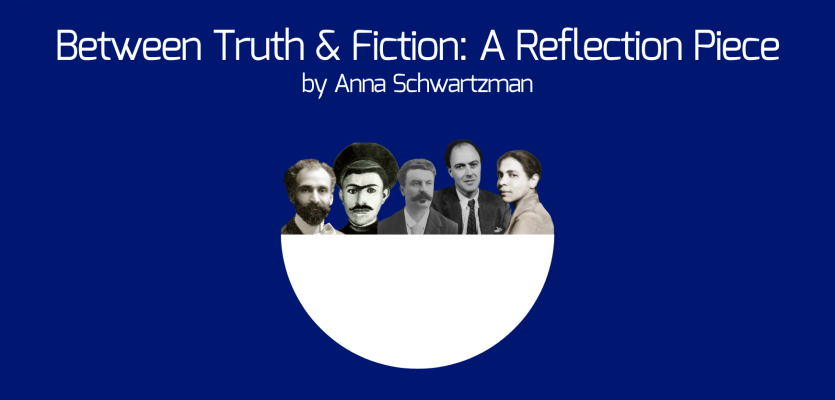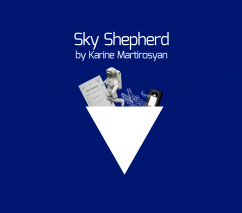Between Truth & Fiction: A Reflection Piece
August 25, 2025
During Between Truth and Fiction, a creative writing lab led by Anna Schwartzman of Columbia University at the TUMO Center in Yerevan, teenagers examined deception in all its forms — from Armenian trickster tales to global myths, modern literature, and the illusions of today’s technologies. Through reading, discussion, and handwritten storytelling, they discovered how lies can harm, protect, or illuminate, and how fiction itself is a kind of artful trickery.
Read Anna's reflection piece below, and explore some students' pieces on h-pem.
In preparation for writing this reflection piece, I scoured the internet for translations of folktales by Pele Pughi and Poloz Mukuch, the great Armenian trickster-storytellers. The workshop lab I was leading had much to do with mythology, and I had become fascinated by these two characters, their positioning between legendary figures and real people who invented stories that so many Armenians had come to know and love. The next day, at dinner in Yerevan, I happened to sit next to Rafał Mierzejewski, a fellow lab leader at TUMO. We were discussing the focus of our labs, which were concluding at the same time, and he mentioned that his students were animating Armenian folktales for their final project. “No way,” I said, my interest piqued. “Not, by any chance, stories by Pele Pughi?” “Yes,” Rafał replied. “How did you know? And Poloz Mukuch, too.” To my great surprise, and purely by coincidence, all of the folk tales that I’d been searching for had been animated by Rafał and his students.
This synchronicity is merely one example of the collaborative spirit and spontaneous innovation ever-present at the TUMO Center for Creative Technologies, a free-of-charge educational program that provides teens across Armenia and beyond with access to top-notch education. Just as TUMO Studios brings fresh life to Armenian craftsmanship through their ateliers, and old folktales are brought to life thanks to new technologies in the hands of skilled animators such as Rafał, there is a possibility – and a necessity – for new stories to be told by the voices of young Armenians. Armenia has a rich history of trickery in its storytelling. There’s Pele Pughi, born in 1731, the wise court jester who often tricked his master into making a fool of himself so that his fear of blundering would not stand in the way of his kingship in Karabakh. There’s Poloz Mukuch, legendary fabulist author, verbal satirist, and schoolmate of the famous Armenian author Avetik Isahakyan. And of course, there’s the famous folktale The Liar, a tale of power reversal beautifully adapted by the great writer and activist Hovhannes Tumanyan.
In our TUMO lab, Between Truth and Fiction, students expanded their understanding of how the theme of deception lives on in literature by examining the global literary tradition and connecting national mythologies to a greater canon. Exploring antiquity, we came to understand that the Greeks and Romans often portrayed cunning as intelligence, as displayed by Athena’s praise of Odysseus and his tricks; in Native American folklore, we followed the escapades of the famous trickster character Coyote, whose deceptions sometimes backfired. More modern literature, such as Passing by Nella Larsen and The Ones Who Walk Away from Omelas by Ursula K. Le Guin, allowed us to explore the polarity between the deception of others and the deception of self. We learned about deadly deceptions, such as Roald Dahl’s Lamb to the Slaughter, and dabbled in the irony-rich tales of Guy De Maupassant. Throughout this panoramic journey, we allowed ourselves to grapple with the big picture: that mythology exists to explain the unexplainable, and that lies are often told in order to make sense of the world. Also, we decided that lying is not always a bad thing: it takes precedence in stories of survival and endurance, and can be protective, taking the shape of stories we tell ourselves to survive. It can be artful withholding, necessary reversals of power.
Being sensitive to the matter of deception is important when it comes to understanding our technological world. The internet has run rampant with fake news, and as a result, real news is often dismissed as fakery; traditionally speaking, politicians have often been so “talented at lying” (Homer, The Odyssey) that it becomes second nature. But this is especially true now, when our modern technology, though allowing for great innovation, can be such a powerful source of trickery: like Coyote of Native American folklore, generative AI has no interiority, no discernible mission. Sometimes, it ends up blundering in such a way that it serves the greater good, but this is mostly by accident. In dialogue, it tells us what we want to hear – what we wish to believe about ourselves – and thus, it is the perfect flatterer. It meets us on the road as a wanderer and thwarts our self-image, offering tempting opportunities to deceive ourselves and others, crushing our confidence if the deception succeeds, blurring the boundary between what’s real and what isn’t until catching the difference is almost impossible. Perhaps the most human thing about generative AI is its propensity to lie, to flatter, to become what we want it to be.
In our learning lab, we intentionally defied this trickster. Students learned the value of sustained attention, writing stories by hand in notebooks, and examined what was lost when we allowed the story to be a conglomeration of all that came before it rather than an innovation of the human mind. Throughout their journey of writing their own stories inspired by the texts of masters, students also understood more tangibly that fiction itself can be thought of as a kind of lie, an illusion created through the manipulation of craft elements such as tone, point of view, pacing, conflict, and irony. The “craftiness” of these choices is, to a certain degree, a kind of trickery – if executed correctly, the story becomes a deception that the reader believes in willingly, even gratefully, in order to learn the truth about themselves. We welcome you into the worlds these talented new writers have crafted over the course of their fifteen-day workshop.
Any additional references or recommendations? We would love to hear your suggestions!
Join our community and receive regular updates!
Join now!





Attention!